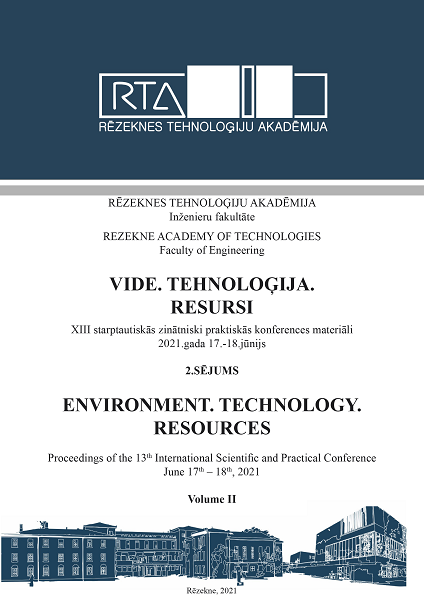COVID-19 NEWS AND AUDIENCE AGGRESSIVENESS: ANALYSIS OF NEWS CONTENT AND AUDIENCE REACTION DURING THE STATE OF EMERGENCY IN LATVIA (2020–2021)
DOI:
https://doi.org/10.17770/etr2021vol2.6564Keywords:
big data, COVID – 19, internet users’ comments, online news, verbal aggressivenessAbstract
This research focuses on the interrelation between news content on COVID-19 of three largest online news sites in Latvia (delfi.lv, apollo.lv, tvnet.lv) and the audience reaction to the news in the Latvian and Russian channels during the state of emergency. By using a tool for audience behaviour analysis, the Index of the Internet Aggressiveness (IIA), for analysis of audience comments, the study aims to uncover how and whether news about COVID-19 affect the level of audience aggressiveness. The study employs two data collection methods: news content analysis and IIA data analysis, in which ten index peaks are selected in each of the two emergency periods (spring 2020, fall and winter 2020/21). The study data consists of content analysis of 400 news items and analysis of ~80,000 comments, identifying the level of aggressiveness, the number and structure of comment keywords. The results show that the level of public aggressiveness is only partially formed by the attitude towards COVID-19 news: less than half of the most aggressively commented news is devoted to information about COVID-19. An increase in the level of aggressiveness of the audience of online news sites can be observed at the end of 2020 and at the beginning of 2021 when it is higher than over the course of 2020.
IIA is an online comment analysis platform, which analyses user-generated comments on news on online news sites according to pre-selected keywords, allowing to grasp the dynamics of commenters’ verbal aggressiveness. In addition, IIA exploits a machine learned classifier to recognize not only potentially aggressive keywords but also to analyse the entire comments. In January 2021, the IIA data set consists of ~24.89 million comments (~611.97 million words) added to ~1.34 million news articles.
References
Gemius Audience, “Domains,” March 2021. [Online]. Available: https://rating.gemius.com/lv/tree/64 [Accessed 15 March 2021].
Rīga Stradiņš University, Survey “Public perception of COVID-19"; N=3413 internet users, Unpublished, April 2020.
A. Tomsons and E. Unāma, “Covid-19 dēļ Latvijas veselības aprūpes sistēmai draud sabrukums. Kāds ir risinājums? [Due to Covid-19, the Latvian health care system is in danger of collapsing. What is the solution?],” LSM, 29 October 2020. [Online]. Available: https://lr1.lsm.lv/lv/raksts/krustpunkta/covid-19-del-latvijas-veselibas-aprupes-sistemai-draud-sabrukums.a136022/
LA/LETA, “"Saņemtas nelāgas ziņas." Pavļuts skaidro, kāpēc Latvijā varētu būtiski kavēties vakcinācija ["Bad news has been received". Pavluts explains why vaccination could be significantly delayed in Latvia],” Latvijas Avīze, 25 January 2021. [Online]. Available: https://www.la.lv/sanemtas-nelagas-zinas-pavluts-skaidro-kapec-latvija-varetu-butiski-kaveties-vakcinacija
Rīga Stradiņš University/SKDS, Survey “Public perception of COVID-19”; N= 1005 internet users, Unpublished, September 2020.
European Centre for Disease Prevention and Control, “COVID-19 situation update for the EU/EEA, as of week 6, updated 18 February,” 18 February 2021. [Online]. Available: https://www.ecdc.europa.eu/en/cases-2019-ncov-eueea
[Accessed 2023 February 2021].
H. Jenkins, Convergence Culture: Where Old and New Media Collide, New York: New York University Press, 2006.
M. Deuze and S. Paulussen, “Research Note: Online Journalism in the Low Countries: Basic, Occupational and Professional Characteristics of Online Journalists in Flanders and the Netherlands,” European Journal of Communication, vol. 17, no. 2, pp. 237-245, 2002. https://doi.org/10.1177/0267323102017002697
E.-J. Lee and Y. J. Jang, “What Do Others’ Reactions to News on Internet Portal Sites Tell Us? Effects of Presentation Format and Readers’ Need for Cognition on Reality Perception,” Communication Research, vol. 37, no. 6, pp. 825-846. https://doi.org/10.1177/0093650210376189
J. Habermas, The Structural Transformation of of the Public Sphere (Thomas Burger and Frederick Lawrence, Trans. Original work published 1962)., Cambridge: MIT Press, 1989.
C. Ruiz, D. Domingo, J. L. Mico, J. Diaz-Noci, K. Meso and P. Masip, “Public Sphere 2.0? The Democratic Qualities of Citizen Debates in Online Newspapers,” The International Journal of Press/Politics, vol. 16, no. 4, pp. 463-487, 2011. https://doi.org/10.1177/1940161211415849
A. Rožukalne, “Internet News about Ukraine and the “Audience Agenda”: Topics, Sources, and the Audience Aggressiveness,” Journalism Research, vol. 8, pp. 17-37, 2015. https://doi.org/10.15388/zt/jr.2015.8.8841
P. Weber, “Discussions in the comments section: Factors influencing participation and interactivity in online newspaper readers comments,” New Media & Society, vol. 16, no. 6, pp. 941-957. https://doi.org/10.1177/1461444813495165
A. Rožukalne, “Aggressive memories or aggressivenesss that changes memories? An analysis of audience reaction to news stories on significant historical events using data from the Index of Aggressiveness,” in Memory - access denied? Political landscapes of memory and inclusion in contemporary Europe, D. Hanovs and I. Gubenko, Eds., Riga, Zinātne, 2018, pp. 117-140.
C. Nau and C. O. Stewart, “Effects of verbal Aggression and Party Identification Bias on Perceptions of Political Speakers,” Journal of Language and Social Psychology, vol. 33, no. 5, pp. 526-536, 2014. https://doi.org/10.1177/0261927X13512486
M. Hutchens, V. Cicchirillo and D. Hmielowski, “How could you think that?!?!: Understanding intentions to engage in political flaming,” New Media & Society, vol. 17, no. 8, pp. 1-19, 2014. https://doi.org/10.1177/1461444814522947
T. B. Ksiazek, L. Peer, K. Lessard, “User engagement with online news: Conceptualizing interactivity and exploring the relationship between online news videos and user comments,” New Media Society, vol. 18, no. 3, pp. 1-19, 2014. https://doi.org/10.1177/1461444814545073
A. N. Joinson, “Self-disclosure in computer-mediated communication: The role of self-awareness and visual anonymity,” European Journal of Social Psychology, vol. 31, no. 2, pp. 177-192, 2001. https://doi.org/10.1002/ejsp.36
G. Garkāje, E. Zilgalve and R. Darģis, “Normalization and Automatized Sentiment. Analysis of Contemporary Online Latvian Language.,” Human Language Technologies – The Baltic Perspective, vol. 268, pp. 83-86, 2014. https://ebooks.iospress.nl/publication/38008
V. Zelče, Ed., Latvijas mediju vides daudzveidība [Diversity of Media Environment in Latvia], Rīga: LU Akadēmiskais apgāds, 2018.
A. Rožukalne, “Monitoring Media Pluralism in the Digital Era: Application of the Media Pluralism Monitor in the European Union, Albania and Turkey in the years 2018-2019. Country report: Latvia.,” European University Institute, 2020. https://cadmus.eui.eu/bitstream/handle/1814/67808/latvia_results_mpm_2020_cmpf.pdf?sequence=1&isAllowed=y



